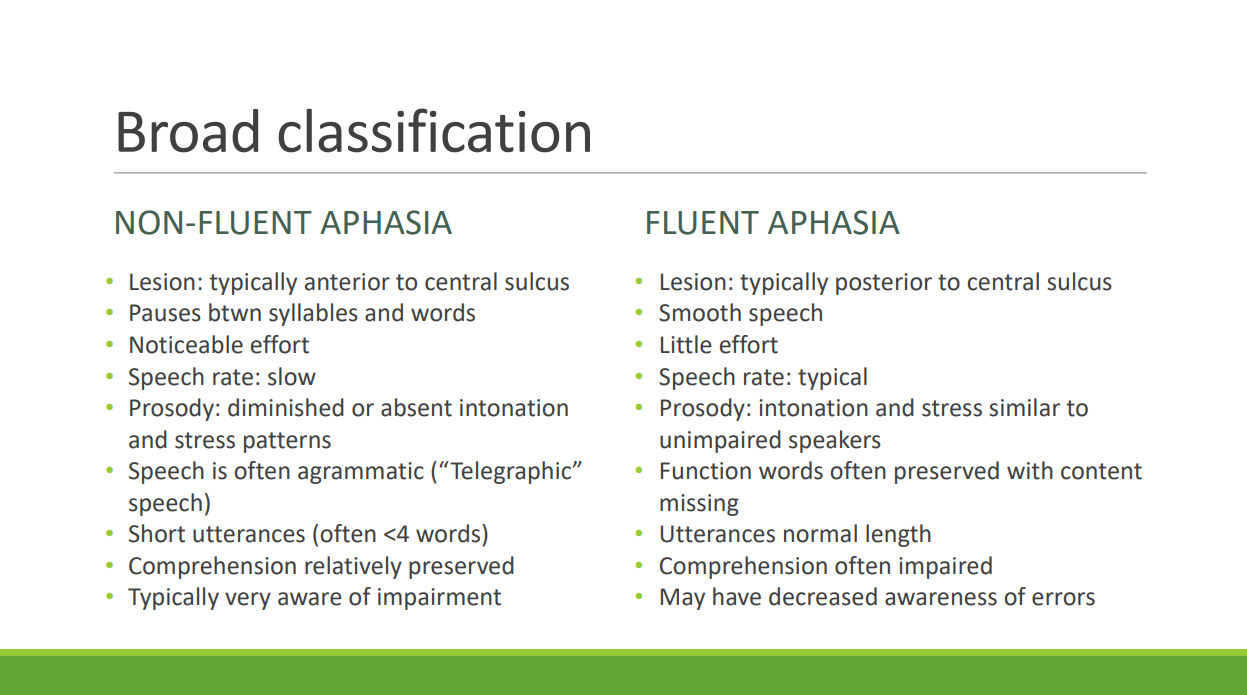Acquired language disorder/Aphasia and Language Variation
What is adult acquired neurogenic communication disorders? What are the main causes?
Neurogenic Communication Disorder: inability to exchange information with others because of hearing, speech, and/or language problems caused by impairment of the nervous system (brain or nerves).
Neurogenic:
◦ Neurologic origin
◦ Damage to central or peripheral nervous system
Causes:
◦ Traumatic brain injury (TBI)
◦ Progressive neurologic disease: dementia
◦ Stroke
Sudden damage to the brain caused by an external force Cognitive-communication disorder
What is aphasia?
Aphasia An acquired neurogenic language disorder resulting from an injury to the brain – most typically in the left hemisphere
1/9
There's no tags or description
Looks like no tags are added yet.
Name | Mastery | Learn | Test | Matching | Spaced |
|---|
No study sessions yet.
10 Terms
What is adult acquired neurogenic communication disorders? What are the main causes?
Neurogenic Communication Disorder: inability to exchange information with others because of hearing, speech, and/or language problems caused by impairment of the nervous system (brain or nerves).
Neurogenic:
◦ Neurologic origin
◦ Damage to central or peripheral nervous system
Causes:
◦ Traumatic brain injury (TBI)
◦ Progressive neurologic disease: dementia
◦ Stroke
Sudden damage to the brain caused by an external force Cognitive-communication disorder
What is aphasia?
Aphasia An acquired neurogenic language disorder resulting from an injury to the brain – most typically in the left hemisphere
What are the symptoms of fluent vs. non-fluent aphasia.
Non-fluent aphasia:
Lesion location is typically anterior – near motor regions of the brain (often includes Broca's area)
Speech sounds effortful; frequent hesitations.
Utterances are short (<4 words).
Speech is often agrammatic (i.e., words are not connected in grammatical strings)
◦ "Telegraphic" speech that lacks functional items like tense markers and articles
Fluent Aphasia
Lesion location is typically posterior near auditory regions of the brain (may include Wernicke's area)
Speech sounds effortless and is usually grammatically well-formed.
Utterances are normal length.
However, speech may not make sense due to word-finding errors and paraphasias (substitution of a word in place of the intended target)

What is anomia? different types of paraphasia?
Anomia is the Inability to retrieve names. Characteristic of ALL types of aphasia and dominant in Wernicke’s aphasia.
Semantic paraphasia (e.g. dog for cat): related to the target in meaning
Phonemic paraphasia(e.g. cap for cat): related to the target in sound
unrelated (e.g. table for cat)
nonwords (neologisms, e.g. caniber for cat): A paraphasia with no clear semantic or phonemic target
empty speech (vague words, e.g. thing, stuff, it)
perseveration (unintended repetition of phonemes or words)
What’s the difference b/w dialect and language?
Dialect: Typically thought of as regional or cultural differences in use of same language
◦ American English vs. British English
◦ New York vs. California
National boundaries play a role in determining dialect
What information does variation convey?
Region
Culture/ethnicity
Class/socioeconomic status (SES)
Age
Gender
Dialect variation is variation for a particular group of individuals.
Individual variation is idiosyncratic language use by one speaker (idiolect).
In what levels of language structure, is language variation observed?
◦ Lexical variation (word choice)
◦ Phonetic/phonological variation (sound production aka pronunciation)
◦ (Morpho-)Syntactic variation (word order and usage)
Examples in dialectal variation in US English (lexical level, phonetic level, and syntactic level)?
Lexical level:
pop vs soda
Sneaker vs tennis shoes
Phonetic level:
caught vs cot
Mary/merry/marry
Syntactic level:
The team / family are happy vs. The team / family is happy
Shall vs. will/should
Needn’t vs. don’t need to
Describe Labov’s study and their findings regarding NYC [r]-lessness.
Asked question whose answer was “fourth floor” in three NYC department stores.
Saks (high SES customers)
Macy’s (middle SES customers)
S. Klein (Union Square) (low SES customers)
Checked whether they said their r’s and predicted that lower SES results in less r’s said.
What’s the register differences?
Speakers use different language registers in different social settingsor contexts
◦ Formal register (e.g., job interview, public setting, teaching?)
◦ Casual register (less complex syntax, more slang)
◦ Child-directed speech register